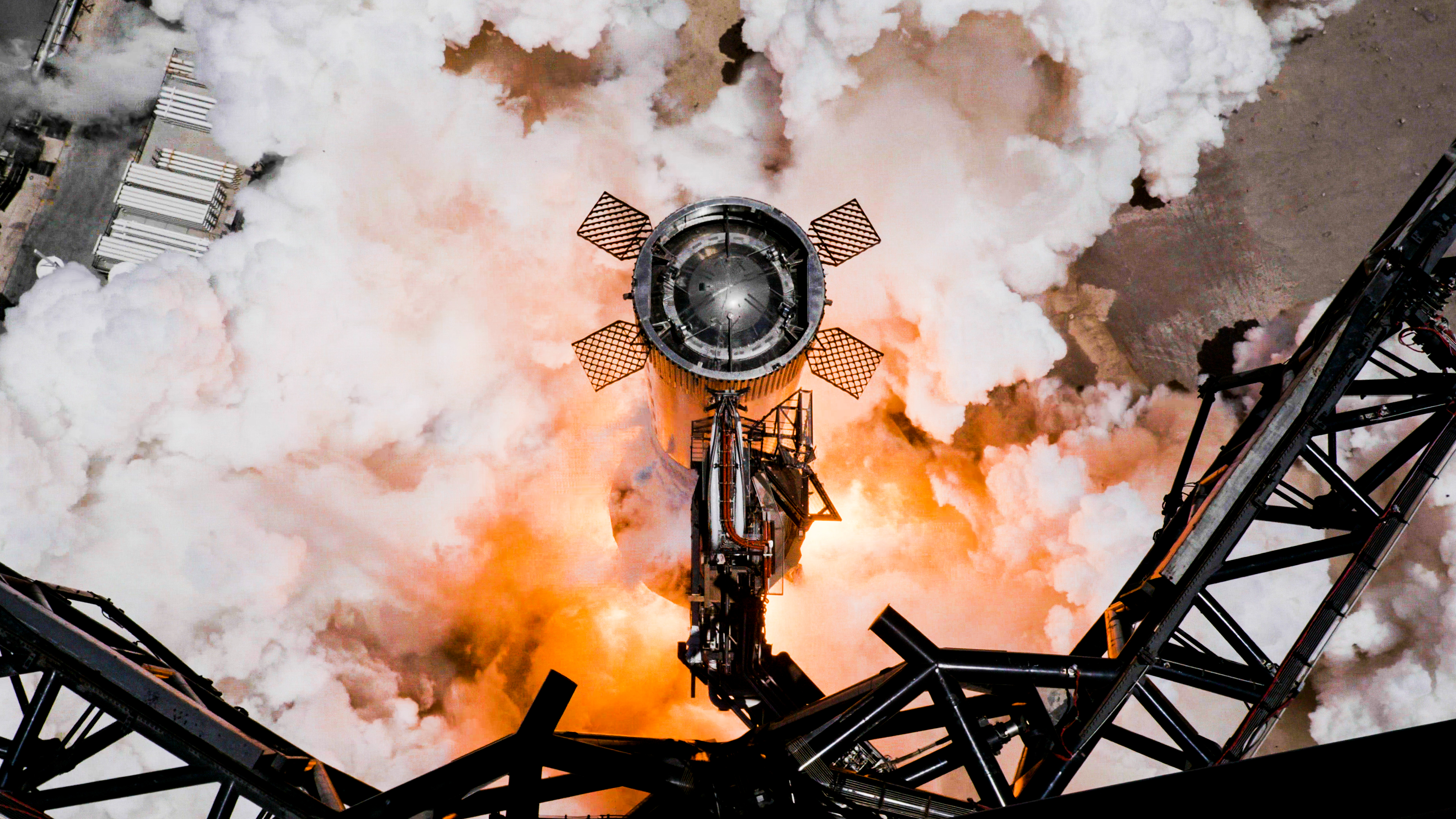
The immense power of SpaceX's Starship Super Heavy booster is on glorious display in newly released photos of a recent engine test.
That test occurred on Sunday (Aug. 6), when SpaceX briefly ignited the 33 Raptor engines of a Super Heavy prototype known as Booster 9 at the company's Starbase site in South Texas.
Four of the Raptors shut down prematurely, SpaceX said during a webcast of the test. But the results were still dramatic and impressive, as the new photos show.
Related: Relive SpaceX's explosive 1st Starship test in incredible launch photos
The images, which SpaceX posted to X (formerly Twitter) on Tuesday (Aug. 8), capture Sunday's "static fire" test from multiple angles.
For example, one photo looks down on Booster 9 from a considerable height, showing orange flames at the rocket's base and waffle-iron-like grid fins, which are designed to help the vehicle steer its way back to Earth after launch, extending from its top.

Another shot provides a closeup of the flames shooting out from the Raptors. A third zooms out a bit, also capturing Booster 9's body, which is coated in white frost thanks to its supercold propellants (liquid methane and liquid oxygen).
Get the Space.com Newsletter
Breaking space news, the latest updates on rocket launches, skywatching events and more!
A fourth photo gives us a wide-angle view of the test, showing both the booster and the immense cloud of dust and exhaust generated by its firing Raptors.

Sunday's static fire was part of the launch prep for Booster 9, which is slated to conduct a test flight in the relatively near future. If all goes according to plan, the vehicle will launch a Starship upper-stage prototype called Ship 25 partway around Earth, with splashdown targeted for the Pacific Ocean near Hawaii.
That's the same basic flight plan as the first and only launch of a fully stacked Starship vehicle to date, which occurred on April 20. That mission ended early, however: Starship's two stages failed to separate, and SpaceX sent a self-destruct command, destroying the vehicle four minutes after liftoff.

SpaceX founder and CEO Elon Musk has said the Booster 9-Ship 25 flight could occur in the coming weeks, but the timeline is unclear.
Part of the uncertainty is logistical. A coalition of environmental and Indigenous groups is currently suing the U.S. Federal Aviation Administration, which grants launch licenses, claiming the agency didn't properly assess the damage that Starlink launches could cause to the South Texas ecosystem and community. (The April 20 launch rained debris on a large area around Starbase.)
Join our Space Forums to keep talking space on the latest missions, night sky and more! And if you have a news tip, correction or comment, let us know at: community@space.com.

Michael Wall is a Senior Space Writer with Space.com and joined the team in 2010. He primarily covers exoplanets, spaceflight and military space, but has been known to dabble in the space art beat. His book about the search for alien life, "Out There," was published on Nov. 13, 2018. Before becoming a science writer, Michael worked as a herpetologist and wildlife biologist. He has a Ph.D. in evolutionary biology from the University of Sydney, Australia, a bachelor's degree from the University of Arizona, and a graduate certificate in science writing from the University of California, Santa Cruz. To find out what his latest project is, you can follow Michael on Twitter.
-
perilun Reply
I think you failed to mention that this was the first static test that employed the new steel plate water exhaust management system. There was a lot of steam but not much dust.Admin said:The immense power of SpaceX's Starship Super Heavy booster is on glorious display in newly released photos of a recent engine test.
These new photos of SpaceX's giant Starship Booster 9 engine test are just gorgeous : Read more -
Mergatroid Reply
They didn't fill the methane tank fully in case there was a problem. They only filled it enough for the test.danR said:Last photo. Puzzled why the methane (top) section looks blue. -
Monzsta Regarding the launch pad issues, why not suspend the rocket over a cliff or build an elevated launch tower that holds the rocket high enough to mitigate the blast in a normal fashion? Rockets move by differential reaction. It doesn't have to be sitting directly on the ground.Reply -
Rob77 Reply
I can only theorize they may have done that to see if there is any frost build up on the surface, would be hard to see if its white against white. Or they just did it to visually identify different sections. 🤷♂️danR said:Last photo. Puzzled why the methane (top) section looks blue. -
Rob77 Reply
I beleive the Chinese do launch from a structure as you have described. I guess to build a base on a cliff has infrastructure / development and high cost issues. But with what we've seen with bigger rockets and the damage they can do, we may see this more in future.Monzsta said:Regarding the launch pad issues, why not suspend the rocket over a cliff or build an elevated launch tower that holds the rocket high enough to mitigate the blast in a normal fashion? Rockets move by differential reaction. It doesn't have to be sitting directly on the ground. -
billslugg In the US you cannot launch over land. FL space is all taken, CA can't launch eastward. The little spot on TX right next to MX is about the only other option. Problem there is the water table is at 3 feet.Reply
They chose an elevated platform and built one about 60 feet high. Apparently it was not high enough.









